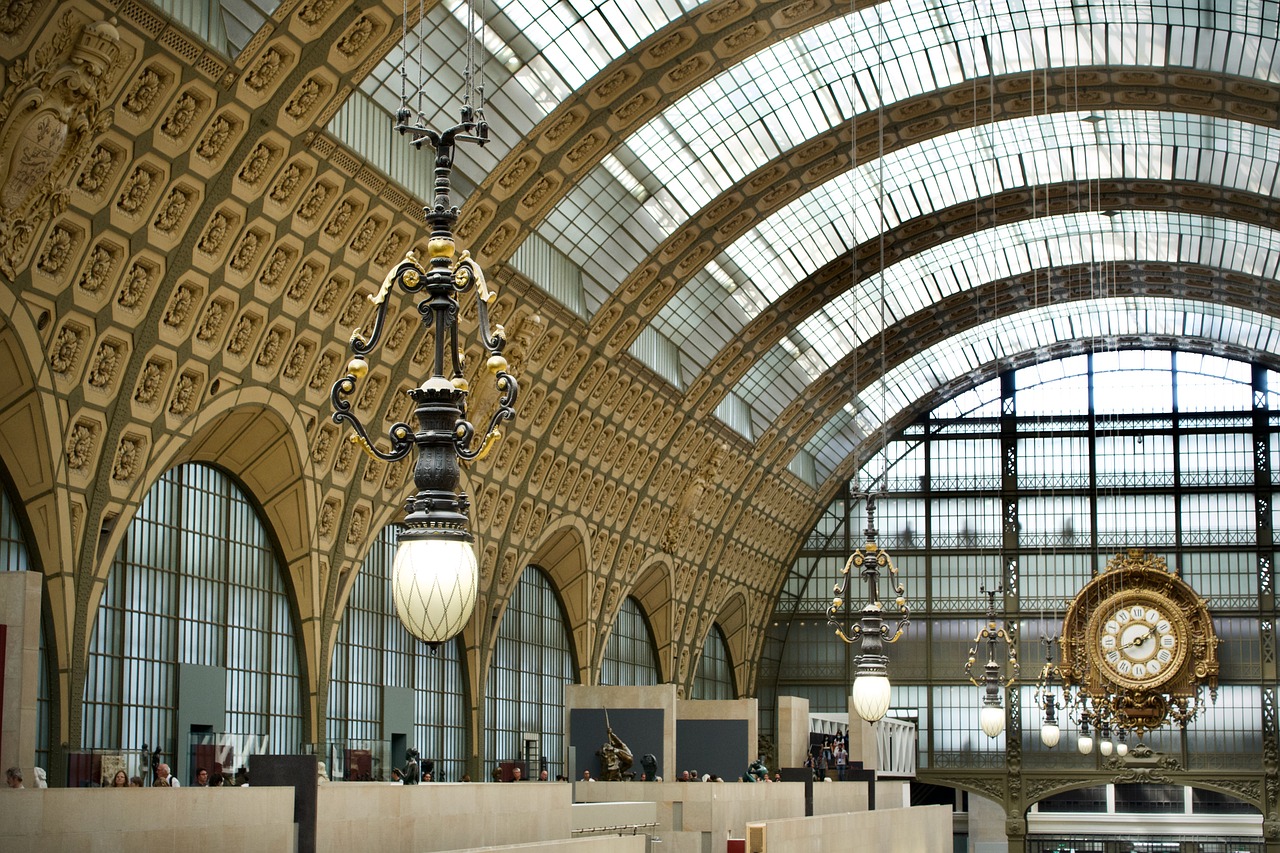The Sublime in Aesthetics - A Study in Kant's Critique of Judgment
The concept of the sublime has long captivated thinkers, artists, and audiences alike, presenting a fascinating intersection of beauty, emotion, and the limits of human understanding. In the realm of aesthetics, Kant's Critique of Judgment serves as a pivotal text that challenges us to reconsider our perceptions of art and nature. What does it mean to experience something as sublime? How does this experience differ from our understanding of beauty? This article embarks on a journey through Kant's aesthetic theory, particularly focusing on the sublime, its emotional resonance, and its implications across various forms of art and nature.
To grasp the essence of the sublime, we first need to explore the foundational principles of Kant's aesthetic theory. Kant believed that aesthetic experiences are not merely subjective feelings but involve a complex interplay between the observer and the object of observation. He posited that beauty arises from a harmonious relationship between the form of an object and the faculties of the observer's mind, leading to a sense of pleasure. However, when we delve into the sublime, we encounter a different emotional landscape altogether. The sublime evokes feelings that transcend mere beauty, often stirring a mix of awe, terror, and admiration.
So, what exactly is the sublime? According to Kant, the sublime is a unique aesthetic experience that arises when we confront something vast, powerful, or incomprehensible. It is an emotional reaction that goes beyond the ordinary, often leaving us feeling small and insignificant in the face of nature's grandeur or the complexities of art. This experience can be both exhilarating and terrifying, as it challenges our rational understanding and pushes the boundaries of our imagination. The sublime compels us to recognize our limitations while simultaneously elevating our spirits, making it a profound aspect of human experience.
Kant identified two primary forms of the sublime: the mathematical and the dynamical. Each type offers a different lens through which we can understand the sublime experience.
The mathematical sublime is characterized by the experience of vastness and infinity. When we encounter something that seems immeasurable—like the night sky filled with stars or the endless expanse of the ocean—we are often struck by feelings of awe and insignificance. This confrontation with the infinite challenges our ability to comprehend the world around us, leading to a profound emotional response that Kant describes as the mathematical sublime. It invites us to ponder our place within the universe and ignites a sense of wonder that is both humbling and exhilarating.
In contrast, the dynamical sublime pertains to the overwhelming power of nature. Imagine standing on the edge of a roaring waterfall or witnessing a fierce storm; the sheer force of these natural phenomena can evoke feelings of fear and admiration. Kant argues that the dynamical sublime inspires us to confront our vulnerability while simultaneously awakening a sense of respect for the forces at play in the universe. This duality of fear and admiration is what makes the dynamical sublime a compelling aspect of our aesthetic experience.
Central to Kant's exploration of the sublime is the role of imagination. He argues that our ability to experience the sublime hinges on our imagination's capacity to reconcile the tension between sensory experience and rational understanding. When faced with the sublime, our senses may struggle to grasp what we are witnessing, yet our imagination allows us to transcend these limitations. It creates a bridge between the overwhelming sensory input and our rational faculties, enabling us to engage with the sublime on a deeper level. This imaginative engagement is what transforms a mere observation into a profound aesthetic experience.
Now that we have a grasp of the sublime's theoretical underpinnings, how does it manifest in the world of art? Artists throughout history have sought to convey sublime experiences, provoking deep emotional responses in their audiences. Through various mediums, they capture the essence of the sublime, inviting viewers to reflect on their own experiences of awe and wonder.
Literary works often evoke the sublime through evocative language and rich imagery. Consider the works of poets like Wordsworth or Coleridge, whose verses transport readers to landscapes that inspire both beauty and terror. Their ability to weave words into a tapestry of emotion allows readers to engage with the sublime on a personal level, often leading to a transformative experience. Notable examples include:
- Wordsworth's "Tintern Abbey" - A reflection on nature's beauty and its profound impact on the human spirit.
- Coleridge's "The Rime of the Ancient Mariner" - A tale that intertwines the beauty of nature with themes of fear and redemption.
In the realm of visual arts, the sublime can be expressed through scale, composition, and color. Iconic artworks, such as Turner’s breathtaking seascapes or Friedrich’s haunting landscapes, embody the sublime through their ability to evoke feelings of awe and introspection. Art critics often analyze these works in terms of their capacity to convey the sublime, exploring how the artist's choices in form and technique contribute to the overall emotional impact.
As we navigate through the rich landscape of Kant's aesthetic theory, we uncover the profound implications of the sublime in art, nature, and human experience. It challenges us to embrace the complexity of our emotions and invites us to explore the depths of our imagination.
Here are some common questions regarding the sublime in aesthetics:
- What is the difference between beauty and the sublime? - Beauty typically evokes pleasure and harmony, while the sublime elicits a mix of awe, fear, and admiration.
- How does the sublime influence modern art? - Contemporary artists often draw on themes of the sublime to provoke emotional responses and challenge perceptions of reality.
- Can the sublime be experienced in everyday life? - Absolutely! Moments of awe, such as witnessing a breathtaking sunset or standing in front of a powerful waterfall, can evoke the sublime.

Understanding Kant's Aesthetic Theory
Immanuel Kant, a pivotal figure in the realm of philosophy, revolutionized our understanding of aesthetics with his profound insights. His aesthetic theory is not just a collection of ideas; it’s a framework that intertwines beauty, taste, and the pivotal role of the observer. Kant posits that aesthetic judgments are subjective yet universal, meaning that while personal tastes may vary, there exists a shared human experience that transcends individual preferences. This duality is what makes Kant's approach so intriguing.
At the heart of Kant's aesthetic theory is the concept of disinterested pleasure. This term might sound a bit complex, but it essentially refers to the enjoyment we derive from beauty without any personal stake or desire for possession. Imagine standing before a breathtaking landscape; you’re not thinking about buying it or changing it, but simply appreciating its essence. This appreciation is what Kant considers the foundation of true aesthetic experience.
Kant also emphasizes the importance of the observer's role in experiencing art and nature. He asserts that the act of perception is active rather than passive. This means that our minds play a crucial role in shaping our aesthetic experiences. When we encounter a piece of art or a natural scene, our imagination engages with the sensory data, leading to a unique interpretation. This interaction between the observer and the observed is what makes aesthetics such a rich field of study.
In Kant's view, aesthetic judgments are grounded in a sense of universality. He argues that when we call something beautiful, we are expressing a sentiment that we believe others should share. This idea is encapsulated in his famous assertion that beauty is a “subjective universality”. It’s a complex notion that suggests while beauty is experienced individually, it carries an implicit expectation that others will appreciate it similarly.
Moreover, Kant categorizes aesthetic experiences into two distinct realms: the beautiful and the sublime. While beauty evokes feelings of harmony and pleasure, the sublime is characterized by a sense of overwhelming grandeur or power that can evoke both fear and admiration. This distinction is crucial for understanding how we engage with different forms of art and nature, as it highlights the varied emotional responses they can elicit.
To further illustrate these concepts, let’s consider a table that outlines the key differences between beauty and the sublime:
| Aspect | Beauty | Sublime |
|---|---|---|
| Emotional Response | Joy, harmony | Awe, fear |
| Nature of Experience | Pleasurable | Overwhelming |
| Examples | Flowers, serene landscapes | Storms, vast mountains |
In conclusion, Kant's aesthetic theory offers a rich tapestry of ideas that challenge us to think deeply about our experiences with art and nature. By emphasizing the interplay between the observer and the observed, Kant invites us to engage actively with our environment, enhancing our understanding of beauty and the sublime. As we delve further into his concepts, we begin to appreciate not just the art itself, but the profound emotional and intellectual journeys it can inspire.
- What is the difference between beauty and the sublime in Kant's theory?
The beauty evokes pleasure and harmony, while the sublime elicits feelings of awe and fear due to its overwhelming nature. - How does Kant define disinterested pleasure?
Disinterested pleasure refers to enjoying beauty without any desire for possession or personal gain. - Why is the role of the observer important in Kant's aesthetics?
Kant believes that the observer actively shapes their aesthetic experience, making perception a crucial part of understanding art and nature.

The Concept of the Sublime
The sublime is a fascinating and complex concept that transcends the ordinary boundaries of aesthetic experience. In Kant's view, the sublime is not merely an extension of beauty; rather, it is a distinct emotional phenomenon that evokes feelings of awe, wonder, and even fear. While beauty delights the senses and provides pleasure, the sublime challenges our understanding and pushes us towards a confrontation with the limits of our comprehension. It's almost like standing at the edge of a vast canyon, feeling both exhilarated and insignificant, as the enormity of nature dwarfs our existence.
To grasp the essence of the sublime, we must recognize its emotional impact on the observer. Unlike beauty, which can be appreciated at a glance, the sublime requires a deeper engagement. It compels us to reflect on our place within the universe and confront feelings that are often uncomfortable. This confrontation can lead to a profound sense of liberation, as we acknowledge the limitations of our understanding while simultaneously reveling in the vastness of what lies beyond.
In Kant's framework, the sublime can be categorized into two distinct types: the mathematical sublime and the dynamical sublime. Each type offers a unique pathway to experiencing the sublime, shaping how we interact with art, nature, and our own emotions. The mathematical sublime invokes feelings of infinity and vastness, while the dynamical sublime draws upon the overwhelming power of nature. Understanding these distinctions is crucial for appreciating the full spectrum of the sublime experience.
Kant's exploration of the sublime leads us to two significant categories that enrich our understanding of this concept:
- Mathematical Sublime: This type emphasizes the vastness and infinity of objects, evoking a sense of awe and insignificance in the observer. Think of gazing at the night sky filled with countless stars; it can make you feel both small and connected to something greater.
- Dynamical Sublime: This form relates to the overwhelming power of nature, such as a raging storm or a towering waterfall. It inspires a mix of fear and admiration, showcasing nature's might while reminding us of our vulnerability.
Both types of the sublime serve to elevate our emotional states, prompting a deeper reflection on our existence and our relationship with the world around us. In this way, the sublime acts as a bridge between our sensory experiences and our rational understanding, allowing us to navigate the complexities of human emotion.
In summary, the concept of the sublime in Kant's aesthetics invites us to engage with the world on a profound level. It challenges us to embrace the unknown and the overwhelming, encouraging a richer, more nuanced understanding of our experiences. The sublime is not just a fleeting moment of beauty; it is a transformative encounter that reshapes our perception of reality.
What is the difference between beauty and the sublime?
The primary difference lies in the emotional response they elicit. Beauty is associated with pleasure and harmony, while the sublime evokes feelings of awe and can even induce fear or discomfort.
Can the sublime be experienced in everyday life?
Absolutely! Moments of the sublime can occur in everyday experiences, such as witnessing a breathtaking sunset, standing before a powerful waterfall, or even through profound art that resonates deeply with us.
How does the sublime influence art and literature?
The sublime inspires artists and writers to explore themes of vastness, power, and emotional depth. It encourages them to push boundaries and evoke strong reactions from their audiences, often leading to a transformative experience.

Types of the Sublime
The concept of the sublime, as articulated by Immanuel Kant, is not a monolithic idea but rather a rich tapestry woven from two distinct yet interconnected threads: the mathematical sublime and the dynamical sublime. Each type offers a unique lens through which we can explore the profound emotional responses that arise when we encounter the vastness of nature or the overwhelming power of the natural world. Understanding these types is essential for grasping the full scope of the sublime experience, as they highlight different aspects of our interaction with beauty and terror.
First, let’s dive into the mathematical sublime. This type is characterized by a sense of vastness and infinity, evoking feelings of awe and insignificance in the observer. Imagine standing at the edge of the Grand Canyon or gazing up at a star-filled sky; the sheer scale of these experiences can be overwhelming. Kant suggests that when we confront something so immense that it dwarfs our comprehension, we are struck by a profound realization of our own limitations. It’s as if we are reminded of our place in the universe, which can be both humbling and exhilarating. This kind of sublime experience often leads us to ponder the infinite, pushing the boundaries of our imagination and understanding.
On the other hand, the dynamical sublime pertains to the raw power of nature. Think of a raging storm, a volcanic eruption, or the crashing waves of the ocean during a tempest. These forces command respect and instill fear, yet they can also inspire admiration. Kant believed that the dynamical sublime arises when we encounter nature’s might, leading to a complex interplay of emotions. We may feel terror at the sheer force of a thunderstorm, but simultaneously, there is a sense of wonder at the beauty of the lightning illuminating the sky. This duality creates a profound aesthetic experience that resonates deeply within us, challenging our perceptions of beauty and fear.
To further illustrate these concepts, consider the following table that contrasts the two types of the sublime:
| Type of Sublime | Characteristics | Emotional Response |
|---|---|---|
| Mathematical Sublime | Vastness, Infinity | Awe, Insignificance |
| Dynamical Sublime | Power, Force of Nature | Fear, Admiration |
In summary, the mathematical and dynamical sublime represent two facets of a larger aesthetic experience. While the mathematical sublime invites us to contemplate the infinite and our role within it, the dynamical sublime confronts us with nature’s raw power, challenging our perceptions of safety and beauty. Together, they enrich our understanding of what it means to experience the sublime, setting the stage for deeper explorations of art, nature, and the human condition.
- What is the difference between beauty and the sublime?
Beauty typically evokes pleasure and harmony, while the sublime elicits feelings of awe and sometimes fear due to its overwhelming nature.
- Can the sublime be experienced in everyday life?
Absolutely! Moments of the sublime can occur in everyday experiences, such as witnessing a breathtaking sunset or feeling small in the presence of towering mountains.
- How do artists convey the sublime in their work?
Artists often use scale, color, and composition to evoke feelings associated with the sublime, whether through dramatic landscapes or powerful imagery in literature.

The Mathematical Sublime
The concept of the mathematical sublime is a fascinating aspect of Kant's aesthetics that delves into the vastness and infinity of objects in nature. When we encounter something that seems immeasurable or boundless—like the expansive night sky or the deep ocean—we often feel a mix of awe and insignificance. This emotional response is what Kant refers to as the mathematical sublime. It's not just about the size of an object; it's about how that size makes us feel. We are reminded of our own limitations, which can be both humbling and exhilarating.
In experiencing the mathematical sublime, we are often confronted with the idea of infinity. Imagine standing at the edge of a vast canyon or gazing up at a star-filled sky. These moments can trigger a profound sense of wonder, as our minds struggle to comprehend the enormity of what lies before us. Kant posits that this overwhelming experience is rooted in our imagination's capacity to grasp the infinite, even when our rational understanding falters. The sublime, then, becomes a bridge between our sensory experiences and our intellectual faculties, allowing us to appreciate the beauty in what we cannot fully understand.
Moreover, the mathematical sublime challenges us to think beyond the physical limitations of our existence. It invites us to consider the following:
- How does encountering vastness affect our perception of self?
- What role does imagination play in reconciling our feelings of insignificance?
- Can the experience of the mathematical sublime lead to a deeper understanding of our place in the universe?
As we reflect on these questions, we begin to see how the mathematical sublime transcends mere aesthetics. It becomes a philosophical inquiry into our existence and our relationship with the world around us. Kant's exploration of this concept opens up a dialogue about the nature of beauty and the limits of human comprehension, allowing us to engage with art and nature on a more profound level.
In summary, the mathematical sublime is not just about the enormity of objects; it's about the emotional and intellectual journey it inspires within us. By confronting the infinite, we are invited to explore the depths of our imagination and the boundaries of our understanding. This exploration can lead to an enriched appreciation of both art and nature, as we learn to find beauty in the vast unknown.
- What is the mathematical sublime? The mathematical sublime refers to the emotional response triggered by encountering vastness or infinity, leading to feelings of awe and insignificance.
- How does Kant differentiate between beauty and the sublime? While beauty is associated with harmony and pleasure, the sublime evokes a more complex emotional response that encompasses awe and fear.
- Can the mathematical sublime be experienced in everyday life? Yes, everyday experiences such as looking at a vast landscape or the night sky can evoke feelings of the mathematical sublime.

The Dynamical Sublime
The concept of the dynamical sublime in Kant's aesthetic theory is a fascinating exploration of how nature's overwhelming power can evoke profound emotional responses. Unlike the mathematical sublime, which focuses on vastness and infinity, the dynamical sublime is rooted in the force and intensity of natural phenomena. Think about standing on the edge of a cliff, watching a storm roll in, or witnessing a volcanic eruption; these moments are filled with a mix of fear and admiration that can leave you breathless. Kant suggests that such experiences challenge our understanding of the world and our place within it.
When we encounter the dynamical sublime, we often feel insignificant in the face of nature's might. This feeling of insignificance is not merely a negative experience; rather, it can lead to a deeper appreciation of the beauty and complexity of the natural world. Kant argues that this emotional response is essential in understanding the sublime, as it forces us to confront our limitations and the limits of our reason.
One of the key aspects of the dynamical sublime is its ability to inspire a sense of awe. This awe arises from the recognition of nature's power, which can be both terrifying and exhilarating. For instance, consider the following examples of natural phenomena that exemplify the dynamical sublime:
- Thunderstorms: The raw power of lightning and thunder can instill both fear and fascination.
- Earthquakes: The ground shaking beneath our feet reminds us of nature's unpredictable force.
- Waterfalls: The sheer volume and speed of water cascading down can evoke feelings of wonder.
In each of these instances, the observer is confronted with a reality that is both beautiful and terrifying. This duality is what makes the dynamical sublime so compelling. It invites us to reflect on our relationship with nature and our own vulnerability. Moreover, Kant emphasizes that the experience of the sublime is not solely about the external phenomenon; it also involves an internal struggle as we reconcile our emotional reactions with our rational understanding.
As we engage with the dynamical sublime, imagination plays a crucial role. It allows us to transcend our immediate sensory experiences and grasp the broader implications of what we are witnessing. For example, when we see a massive tidal wave crashing against the shore, our imagination can take us beyond the moment, prompting thoughts about the power of nature, the fragility of human life, and the interconnectedness of all things. This imaginative engagement elevates the experience from mere observation to profound reflection.
In summary, the dynamical sublime is a powerful concept that captures the essence of our emotional responses to nature's might. It challenges us to confront our fears while simultaneously inspiring admiration for the beauty that lies within that fear. By understanding the dynamical sublime, we not only deepen our appreciation for the natural world but also enrich our own aesthetic experiences.
What is the difference between the mathematical sublime and the dynamical sublime?
The mathematical sublime focuses on concepts of vastness and infinity, evoking feelings of awe through scale, while the dynamical sublime is rooted in the power and intensity of natural phenomena, inspiring a mix of fear and admiration.
How does imagination contribute to the experience of the dynamical sublime?
Imagination allows us to transcend our immediate sensory experiences, prompting deeper reflections on our relationship with nature and the emotional responses we encounter.
Can the dynamical sublime be found in art?
Yes, the dynamical sublime can manifest in art through representations of powerful natural forces, capturing the awe and fear associated with such experiences.

The Role of Imagination
Imagination, in Kant's aesthetic framework, serves as a vital bridge between our sensory experiences and our rational understanding. It is through imagination that we can transcend the mere observation of beauty and venture into the realm of the sublime. When we encounter something that is truly sublime—be it an awe-inspiring landscape, a powerful piece of music, or a gripping piece of literature—our senses are overwhelmed, and it is the imagination that allows us to process and reconcile these intense feelings. But what exactly does this mean for our experience of art and nature?
Consider the moment you stand at the edge of a vast canyon, the sheer drop and expansive view stretching out before you. Your senses are bombarded by the scale and beauty of the scene. Yet, it is your imagination that fills in the gaps. It conjures up thoughts of the forces that shaped the canyon, the eons of time it took for nature to carve such a masterpiece. This ability to envision the unimaginable—vastness, depth, and the passage of time—evokes a profound emotional response that surpasses simple appreciation of beauty. It is this emotional resonance that Kant believed was essential to experiencing the sublime.
Imagination does not merely react to what we see; it actively engages with it, transforming our perception into something deeper. This engagement can be understood through several key functions of the imagination:
- Transcendence: Imagination allows us to rise above our immediate sensory experience, enabling us to grasp concepts like infinity and eternity.
- Reconciliation: It helps reconcile the tension between our fear of the overwhelming and our admiration for its beauty.
- Interpretation: Imagination aids in interpreting the emotional weight of an experience, allowing us to articulate feelings that might otherwise remain unexpressed.
Through this lens, we can appreciate how imagination not only enhances our aesthetic experience but also shapes our understanding of the sublime. It is this interplay that makes the sublime a uniquely human experience, one that invites us to explore the depths of our emotional and intellectual capacities. Kant posited that the sublime experience is not just about what we see or feel; it’s about how we engage with those sensations and ideas through our imagination.
In conclusion, the role of imagination in experiencing the sublime is both profound and complex. It transforms our perceptions, allowing us to grapple with the vastness of existence and the power of nature. As we continue to explore the sublime in art and nature, we must remember that it is our imagination that unlocks the door to these extraordinary experiences, inviting us to delve deeper into the essence of what it means to be human.
1. What is the sublime according to Kant?
The sublime, in Kant's view, is an aesthetic experience that transcends beauty, evoking feelings of awe and insignificance in the face of vastness or power.
2. How does imagination contribute to the experience of the sublime?
Imagination allows individuals to reconcile sensory overload with rational understanding, transforming overwhelming experiences into profound emotional responses.
3. What are the two types of the sublime identified by Kant?
Kant distinguishes between the mathematical sublime, which relates to concepts of vastness and infinity, and the dynamical sublime, which pertains to the overwhelming power of nature.
4. Can the sublime be found in art?
Yes, the sublime can manifest in various art forms, where artists convey profound emotional experiences that resonate deeply with audiences.

The Sublime in Art
The sublime in art is like a powerful wave crashing against the shore—both beautiful and terrifying, it evokes a visceral reaction that lingers long after the experience. Artists have long sought to capture this profound emotional response, using various techniques and mediums to convey feelings that transcend mere aesthetics. Whether through literature, painting, or sculpture, the sublime invites viewers to confront their own emotions and the vastness of existence. It’s not just about what we see, but what we feel when we engage with art. The sublime can transport us, making us feel small in the grand scheme of things, yet simultaneously connected to something much larger.
One of the most fascinating aspects of the sublime in art is how it challenges our perceptions and emotions. It often pushes boundaries, making us question our understanding of beauty and fear. Artists like J.M.W. Turner and Caspar David Friedrich have masterfully illustrated the sublime through their landscapes, where the vastness of nature is depicted in a way that leaves us breathless. Their works compel us to reflect on our own existence and the overwhelming power of the natural world. In this way, the sublime becomes a catalyst for introspection, inviting us to ponder our place within the universe.
Moreover, the sublime is not limited to visual arts; it permeates literature as well. Writers such as Mary Shelley and Edgar Allan Poe have woven elements of the sublime into their narratives, creating atmospheres that evoke a deep sense of awe and terror. Through their prose, they explore themes of human fragility in the face of nature's might or the unknown, prompting readers to grapple with their own fears and desires. The emotional impact of such works is profound, as they resonate with our deepest anxieties while simultaneously offering a glimpse of beauty amidst chaos.
To better understand the relationship between the sublime and various art forms, let’s explore some key examples:
| Art Form | Notable Artists/Authors | Representative Works |
|---|---|---|
| Visual Arts | J.M.W. Turner, Caspar David Friedrich | "The Fighting Temeraire", "Wanderer above the Sea of Fog" |
| Literature | Mary Shelley, Edgar Allan Poe | "Frankenstein", "The Raven" |
As we delve deeper into the sublime, we begin to understand its intricate relationship with the human experience. It serves as a reminder that art is not just a reflection of beauty but also an exploration of the complexities of life. The sublime can be found in the quiet moments of introspection as well as in the chaotic bursts of emotion. It challenges us to confront our fears and embrace the unknown, ultimately leading to a richer understanding of ourselves and the world around us.
In conclusion, the sublime in art is a powerful force that elicits strong emotional responses and encourages deep reflection. It transcends the boundaries of traditional aesthetics, inviting both artists and audiences to explore the vastness of human experience. Through the lens of the sublime, we can appreciate art not merely as a visual or literary expression, but as a profound journey into the depths of our own emotions and the mysteries of existence.
- What is the sublime in art? The sublime in art refers to the emotional experience that evokes awe and terror, often challenging our perceptions of beauty and existence.
- How do artists convey the sublime? Artists convey the sublime through various techniques, including scale, composition, and imagery that provoke deep emotional responses.
- Can literature evoke the sublime? Yes, literature can evoke the sublime through powerful language and themes that explore human fragility and the vastness of nature.
- Who are some notable artists associated with the sublime? Notable artists include J.M.W. Turner and Caspar David Friedrich in visual arts, and Mary Shelley and Edgar Allan Poe in literature.

Literature and the Sublime
When we dive into the realm of literature, the sublime often emerges as a powerful force that transcends mere words on a page. It’s not just about telling a story; it’s about evoking emotions that resonate deep within us, stirring feelings of awe, wonder, and sometimes even terror. Think about it: how can a simple narrative transport us to a place where we feel both insignificant and profoundly connected to something greater than ourselves? This is the magic of the sublime in literature.
Many renowned authors have skillfully woven the sublime into their works, creating landscapes of thought and emotion that challenge our perceptions. For instance, the poetry of William Wordsworth often captures the sublime nature of the natural world. In his famous poem, "Tintern Abbey," he reflects on the overwhelming beauty of nature, which evokes a sense of peace and introspection. The way he describes the scenery not only paints a picture but also stirs a deep emotional response, inviting readers to experience the sublime alongside him.
Similarly, Mary Shelley’s "Frankenstein" explores the sublime through the lens of human ambition and the terrifying power of nature. The monstrous creation of Victor Frankenstein embodies the chaotic forces of nature that can inspire both admiration and dread. Shelley’s vivid descriptions of the icy landscapes and the tempestuous weather serve to amplify the emotional stakes of her narrative, highlighting the duality of beauty and horror that defines the sublime.
Let’s not forget the role of language itself in evoking the sublime. The use of metaphors, imagery, and symbolism can elevate a text from the ordinary to the extraordinary. For example, in the works of Edgar Allan Poe, the sublime often manifests through dark and haunting imagery that evokes feelings of fear and fascination. His poem "The Raven" is a prime example, where the eerie atmosphere and the torment of the narrator create a sublime experience that grips readers from start to finish.
To illustrate the impact of sublime literature, consider the following table that highlights key authors and their works that encapsulate the essence of the sublime:
| Author | Work | Elements of the Sublime |
|---|---|---|
| William Wordsworth | Tintern Abbey | Nature's beauty, introspection |
| Mary Shelley | Frankenstein | Human ambition, power of nature |
| Edgar Allan Poe | The Raven | Dark imagery, emotional torment |
| John Keats | Ode to a Nightingale | Transcendence, beauty of nature |
In summary, literature serves as a powerful medium for expressing the sublime, allowing readers to engage with profound emotional experiences that challenge their understanding of beauty and terror. Whether through poetry, prose, or drama, the sublime in literature invites us to confront our deepest fears and aspirations, ultimately enriching our human experience.
- What is the sublime in literature? The sublime in literature refers to moments that evoke awe, wonder, or terror through powerful imagery and themes, often challenging the reader's perception of beauty and reality.
- How do authors create a sense of the sublime? Authors create a sense of the sublime by using vivid descriptions, metaphors, and exploring themes that evoke strong emotional responses, such as nature's beauty or human ambition.
- Can the sublime be found in all literary genres? Yes, while the sublime is often associated with poetry and romantic literature, it can be found in various genres, including fiction, drama, and even non-fiction.

Visual Arts and the Sublime
The sublime in visual arts is an exhilarating experience that transcends mere aesthetics, inviting viewers into a realm where emotion and intellect collide. Artists have long sought to capture this profound essence, using techniques that provoke not just admiration but a deeper, almost spiritual response. Think of standing before a vast landscape painting or a colossal sculpture; the sheer scale can leave you breathless, evoking feelings of awe and insignificance. This is where the sublime takes center stage, challenging our perceptions and stirring our souls.
One of the primary ways the sublime manifests in visual arts is through scale. Consider the works of artists like Caspar David Friedrich, whose landscapes often feature towering mountains and expansive skies. These elements create a sense of vastness that can make viewers feel both small and connected to something greater than themselves. Friedrich’s painting, "Wanderer above the Sea of Fog," is a quintessential example, where the solitary figure gazes into an infinite sea of mist, embodying the tension between human vulnerability and the grandeur of nature.
Moreover, the use of composition plays a crucial role in eliciting sublime experiences. Artists often arrange elements in a way that guides the viewer's eye, creating a journey through the artwork. Take the works of J.M.W. Turner, for instance, whose dramatic use of light and color in paintings like "The Slave Ship" captures the tumultuous power of nature. The swirling clouds and crashing waves evoke a sense of chaos and beauty, forcing the viewer to confront the sublime terror of nature’s might.
Color, too, is a powerful tool in conveying the sublime. The emotional weight of color can evoke feelings of tranquility, terror, or ecstasy. Artists like Mark Rothko use large fields of color to create immersive experiences that invite introspection. Standing before a Rothko painting can feel like being enveloped in a vast emotional landscape, where the colors resonate with our innermost feelings, prompting us to reflect on our existence and our place in the universe.
To further illustrate the connection between visual arts and the sublime, we can look at a few iconic artworks that exemplify this relationship:
| Artwork | Artist | Key Elements of the Sublime |
|---|---|---|
| Wanderer above the Sea of Fog | Caspar David Friedrich | Vastness, solitude, nature's grandeur |
| The Slave Ship | J.M.W. Turner | Dramatic light, chaos, emotional intensity |
| Orange, Red, Yellow | Mark Rothko | Immersive color fields, emotional resonance |
In conclusion, the sublime in visual arts serves as a bridge between the tangible and the intangible, urging us to confront our emotions and the vastness of existence. Through scale, composition, and color, artists craft experiences that challenge our perception of reality, inviting us to explore the depths of our feelings and thoughts. This exploration is not just about appreciating beauty; it’s about engaging with the profound mysteries of life itself.
- What is the sublime in visual arts? The sublime in visual arts refers to the emotional and intellectual responses elicited by artworks that evoke feelings of awe, grandeur, and sometimes terror, often through scale, composition, and color.
- How do artists convey the sublime? Artists convey the sublime by using techniques that emphasize vastness, dramatic light, and immersive color, creating a sense of connection between the viewer and the artwork.
- Can the sublime be found in modern art? Yes, the sublime can be found in modern art, as contemporary artists continue to explore themes of vastness and emotional depth through innovative mediums and techniques.
Frequently Asked Questions
- What is the sublime according to Kant?
The sublime, in Kant's view, is an aesthetic experience that transcends mere beauty. It evokes a feeling of awe and wonder, often accompanied by a sense of insignificance in the face of vastness or overwhelming power. Unlike beauty, which pleases the senses, the sublime challenges our understanding and stirs deep emotions.
- How does Kant differentiate between beauty and the sublime?
Kant distinguishes beauty as a harmonious and pleasing experience that evokes satisfaction, while the sublime is characterized by feelings of terror or awe. Beauty is about proportion and balance, whereas the sublime confronts us with something that seems beyond our comprehension, leading to a mixture of admiration and fear.
- What are the two types of the sublime identified by Kant?
Kant identifies two forms of the sublime: the mathematical sublime and the dynamical sublime. The mathematical sublime relates to the vastness and infinity of objects, making us feel small and insignificant. The dynamical sublime, on the other hand, pertains to the overwhelming power of nature, evoking feelings of both fear and admiration.
- Can you explain the mathematical sublime?
The mathematical sublime is experienced when we confront the vastness of nature or the universe. It evokes feelings of awe as we grapple with concepts of infinity and enormity, making us aware of our own limitations and sparking a profound sense of wonder.
- What is the dynamical sublime?
The dynamical sublime is related to the power and force of nature, such as storms, mountains, or natural disasters. This type of sublime experience can be frightening yet exhilarating, as it highlights nature's might and our vulnerability, leading to a deep emotional response.
- What role does imagination play in experiencing the sublime?
Kant argues that imagination is crucial in experiencing the sublime. It helps us reconcile the tension between our sensory experiences and rational understanding. Through imagination, we can grasp the magnitude of the sublime, allowing us to appreciate its emotional impact fully.
- How is the sublime represented in art?
The sublime in art can be expressed through scale, composition, and color. Artists often use these elements to evoke feelings of awe and wonder in their audiences. Iconic artworks that embody the sublime challenge viewers to confront their emotions and perceptions, leading to a deeper engagement with the piece.
- Can literature evoke the sublime?
Absolutely! Literature often evokes the sublime through powerful language and imagery. Authors can transport readers to vast landscapes or intense emotional experiences, allowing them to feel the awe and wonder that accompanies the sublime. Notable examples include works that explore themes of nature, existence, and the human condition.
- What are some famous examples of the sublime in visual arts?
Iconic artworks that embody the sublime include Caspar David Friedrich's "Wanderer above the Sea of Fog" and J.M.W. Turner's "The Slave Ship." These pieces utilize scale, dramatic landscapes, and emotional intensity to evoke a sense of the sublime, inviting viewers to reflect on their place within the vastness of nature.



















